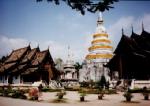

 THAILAND ( Prathet
Thai -
Land of the Free )
THAILAND ( Prathet
Thai -
Land of the Free ) 
Southern Thailand:
Malaysian Border to Bangkok:
Northern Thailand:
"Where you go?", demanded the uniformed bus boy as I approached the baw kaw saw ( local bus terminal ). Taking my bags he escorted me to the appropriate stance. With its extensive, state-controlled network travel by bus in Thailand is both easy and inexpensive.
 Local Bus
Station ( Baw Kaw Saw )
|
However it can be a real culture shock on entering this exotic, asian country for the first time. Not only are most of the signs in the outlandish, seemingly indecipherable Thai script ( it makes Greek look simple ) but few people ( voluntarily ) speak English ( although it is the main foreign language taught in schools ). With its tonal system the Thai language ( pasa Thai ) is strange and difficult for westerners to assimilate - each set of letters can be pronounced using five different tones ( high, low, middle, rising, falling ) to generate five different words - usually one of which should not be used in polite society.
Conversely, refined English speakers may find the speech of Thai men offensive - in polite Thai they add khrap to the end of each sentence as in:- khawp khun khrap ( thank you ), sawat dii khrap ( Thai greeting/ farewell ). ( Thai women use kha ). As in Malaysia, and many other countries of SE Asia, there is a significant Chinese minority. Like the Thais however, they also practice the Buddhist faith, though a different branch with different temples, and there is a high degree of integration - unlike in Malaysia where the different ethnic groups co-exist but with little integration.
Local hotels are invariably run by Chinese Thais and costs are comparable with those in Malaysia at around 200Baht ( £1 = 60Baht ) per night.
The South West Coast:
Travelling by rot meh thammarat ( ordinary bus ) I headed northwards via the bustling cities of Hat Yai and Trang to explore the spectacular scenery surrounding the coastal towns of Krabi and Phang Nga.
Krabi:
From the 'window' on the tall, limestone stack rising prominently above Laem Phra Nang ( Laem - cape ) there is a magnificent aerial view over the twin arcs of golden sand separated by dense groves of coconut palms concealing clusters of thatched-roofed bungalows. Only by boat is access possible to this isolated isthmus and the bright blue waters of the two opposing bays were scarred by the white wakes of the long-tailed ferries bringing new arrivals around the headlands from the longer, but busier, beach of Ao Nang ( Ao - bay ) or directly from the nearby estuarine town of Krabi.
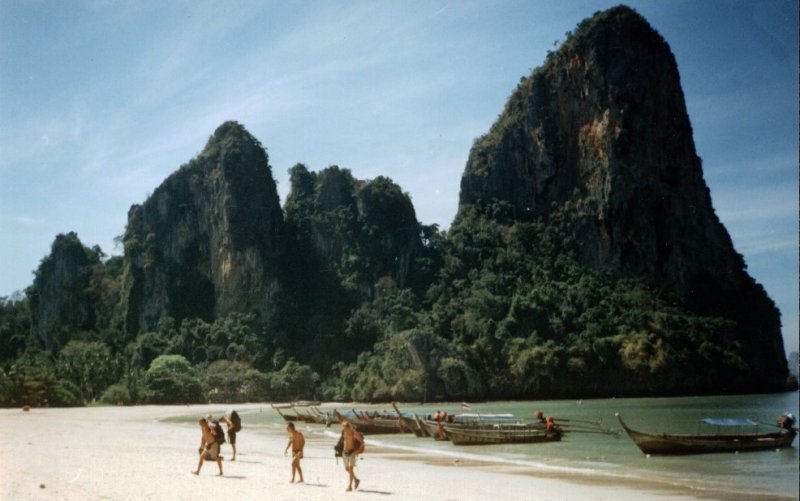 Ao Nang near
Krabi
|
One of the delights of Thailand is the abundance of inexpensive tropical fruits. Freshly prepared pineapple, papaya, melon and other exotic fruits are widely available from street vendors. Better buys can be obtained direct from the fruit markets. A local speciality are the 'Princess's finger-nail' bananas - whole bunches can be bought for a few baht. However the durian, held in esteem by Thais, is an acquired taste with its sweet yellow flesh but pungent, not to say noxious, odour and is probably best avoided ( it has been likened to eating ice-cream smelling of garlic ).
Dining out is rarely a problem with the plethora of foodstalls and restaurants, surprisingly many with English menus. Eating is one of the pleasures ( sanuk) of Thai people and their national cuisine is varied and exotic with a tendency to be hot and spicy - as with the durian some dishes are best avoided. In extremity one can always ask for the ubiquitous fried rice ( khao phat - pronounced cow pat ). Young Thais are partial to the hybrid khao phat americaine ( american fried rice ).
Ao Phang Nga:
Further North from Krabi, in the large bay near the town of Phang Nga, wierdly-shaped, limestone outcrops rise dramatically from the sea. This was the location for 'The Man with the Golden Gun' - one of the attractions being the small, strangely shaped island of Khao Ping Gan now dubbed 'James Bond Island'.
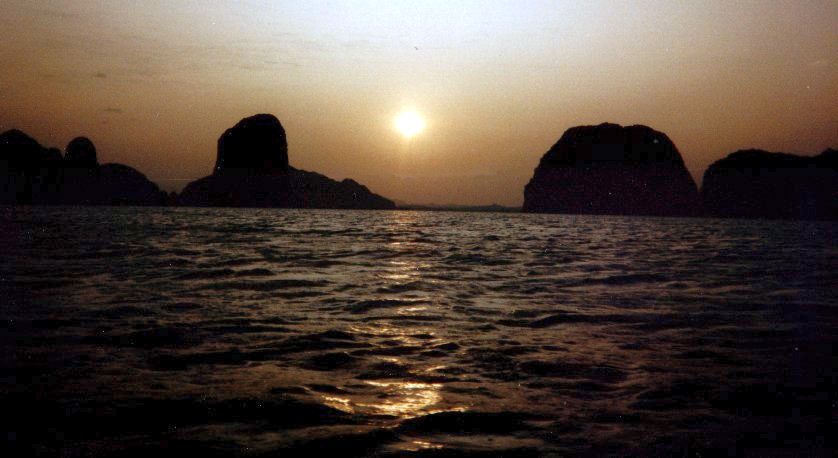 Sunset cruise
on Phang Nga Bay
|
On a two-day trip organised by Sayan, a local postman, I was ferried around the bay in a long-tailed boat to explore the astonishing variety of islands and the many semi-submerged caves and grottoes with gigantic stalactites and stalagmites. Included in the tour was a sun-set cruise, when the islands are hauntingly beautiful, a superb sea-food dinner and an overnight stay in Sayan's house in the Moslem fishing village, built entirely on stilts, on Ko Panyi ( ko / koh - island ).
Ko Phuket:
Less than two hours from Phang Nga is Sarasin Bridge linking Ko Phuket , Thailand's largest island ( about the same size as Singapore ) to the mainland.
Kata, Karon and Ao Patong are the most popular tourist beaches - nice enough for sand,sea and sun but I prefer the less-developed, more scenic and tranquil beaches of Hat Kamala ( hat - beach ) and Ao Bang Tao which are also on the western coast of Ko Phuket.
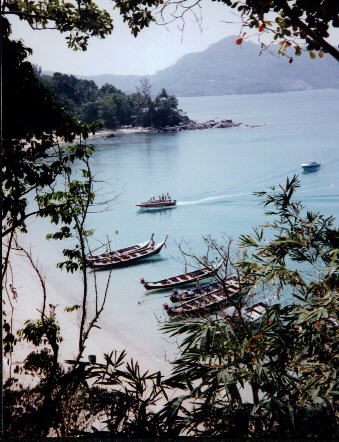 Secluded bay on
Ko Phuket
|
Rather than stay in the beach bungalows I choose to stay in the charismatic On On Hotel, with its quaint Sino-Portuguese architecture, in Phuket Town at the southern end of the island, where there is a greater range of amenities. A day trip to any of the beaches is then possible by songthaew ( pick-up truck with two opposing bench seats used throughout Thailand for short distance local transport ).
North to Bangkok:
Ranong:
For the longer leg of my journey from Phuket northwards along the Andeman Sea coast to the small port of Ranong I travelled in one of the more expensive, but faster, air-conditioned buses.
Situated just across the Chan River from neighbouring Burma ( or Myanmar as it has been re-named by its current military government ) the markets and streets of Ranong are full of Burmese men conspicuous in their brightly-coloured longyis .
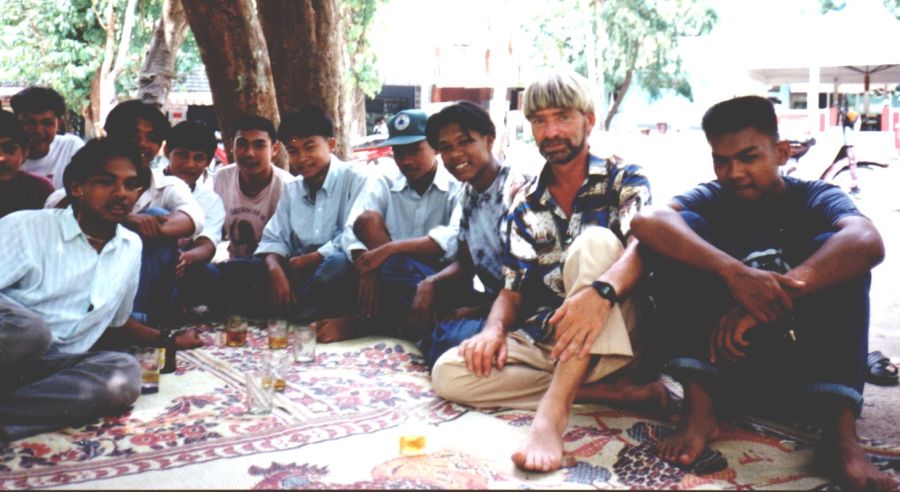 Picnic in the
park at Ranong
|
In the riverside park enclosing the hot springs, as a lone farang ( foreigner ), I was invited by several groups of friendly, hospitable Thais to join their family picnics.
Prachuap Kiri Khan:
From Ranong it is a half day through extensive rubber plantations to cross the peninsula to the junction town of Chumpon and then another short trip northwards along the Gulf of Thailand to the quiet, untouristed Prachuap Kiri Khan.
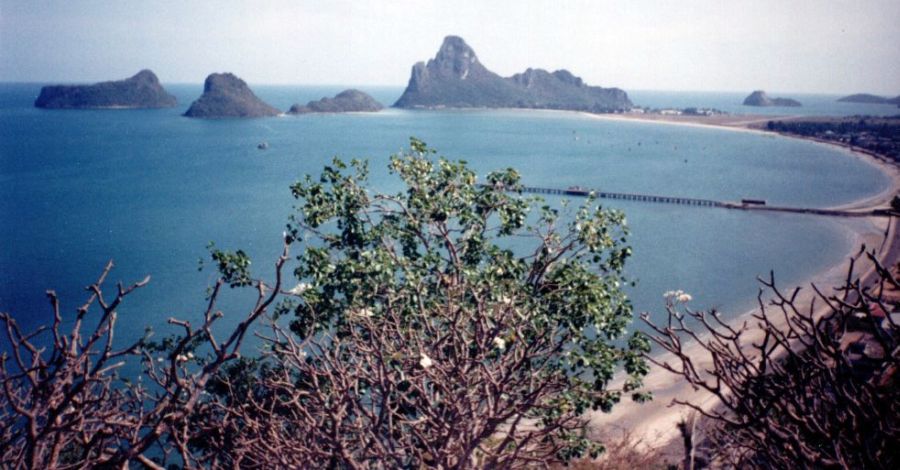 Prachuap Kiri
Khan
|
Running the gauntlet of a horde of inquisitive monkeys I climbed the long stone staircase to the tiny, ornate wat ( Thai Buddhist temple ) perched on the very summit of a small hill to gain a splendid outlook over the town and the 8Km white-sand beach, backed by casuarina trees, sweeping round Ao Prachuap to the distant fishing village of Bang Nang Lom nestling beneath soaring limestone cliffs. From the edge of town a long pier extends into the bay - deserted during the day it becomes a hive of floodlit activity in the evenings when the fishing boats unload their catches and load supplies for their next trip.
Hua Hin:
Up the coast the traditional Thai beach resort of Hua Hin has been overtaken by the international tourist trade. Modern, high-rise, all-air-con hotels, catering for the two-week-a-year, package-holidaymaker now loom over the two-storeyed, family-run, fan-room guest-houses catering for the 12-month, round-the-world, budget-travel, back-packer. However both types of tourist mingle on the beach and in the bars and restaurants.
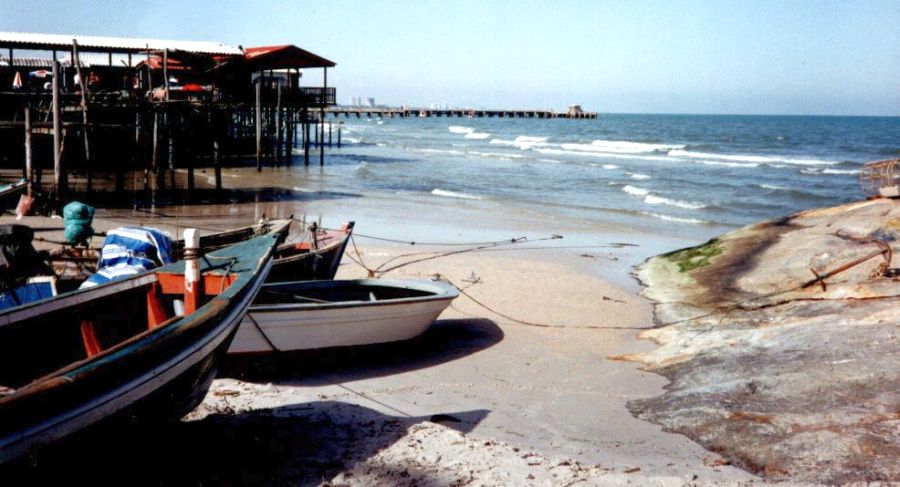 Waterfront at
Hua Hin
|
The rickshaw driver was none too pleased when I got him to let me off at the Moti Mahal Guest House - he had been expecting to get a commission by delivering me elsewhere. On checking-in I was delighted to find that the new manager Kumar, and the rest of his staff, were Nepalese. Later that evening we enjoyed an exchange in Nepali and they were interested in photos of my recent trek in the Himalaya.
The restored glory of the local Royal Thai Railway Hotel, now re-named Hotel Sofitel Central, was featured in "The Killing Fields" as Hotel Le Phnom.
Bangkok ( Krung Thep - "City of Angels" ):
Three hours from Hua Hin one enters the horrendous traffic jams of Bangkok - drivers have been advised by the city authorities to carry 'portaloos'.
However once installed in one of the many guest-houses or hotels in Khao San Road in the globetrotters' centre of Banglamphu most places of interest are then within walking distance - although crossing roads is dangerous. Motorbikes are a particular hazard appearing from nowhere and from unexpected directions. It is not unusual to see ( two-wheel ) motorbikes carrying whole families of five - two parents and three children - one perched on the handlebars, one sandwiched between the parents and one hanging on behind - none wearing crash helmets.
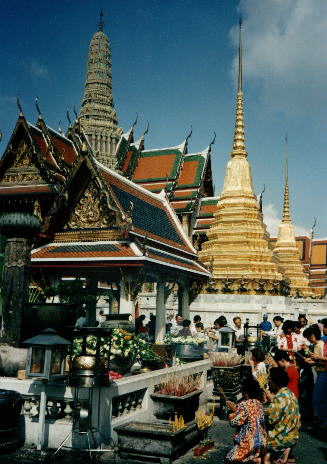 Wat Phra Keo in
Bangkok
|
|
Joining the throng of other tourists I entered the massive, white-washed battlements enclosing the Old Royal City to inspect the quintessentially Thai architecture of the Grand Palace and Wat Phra Keo ( The Temple of The Emerald Buddha ) with dazzling, gilded chedis ( bell-shaped towers with tall, tapering spires ) and elaborately decorated prangs ( tall, finger-like spires ) surrounding the ornate, gaudy pavilions. The adjoining Wat Pho ( The Temple of the Reclining Buddha ) contains the greatest collection of Buddha images in Thailand. The rows upon rows of gilded, seated figures around a cloistered courtyard ( bot ) are typical of Thai temples.
A mere 1Baht is the fare for the public ferry across the broad, swiftly-flowing Chao Phraya River to the spectacular Wat Arun - The Temple of Dawn - with its 82metre high prang embedded with multi-coloured, porcelain tiles to reflect the rays of the morning sun. From the uppermost terrace there is a splendid view back across the busy river to the ornate buildings of the Old Royal City.
 Wat Arun,
Temple of Dawn,
in Bangkok |
Another fine outlook over Bangkok is obtained by climbing the winding stairway to the top of the Golden Mount above Wat Saket near to the Democracy Monument.
The omnipresent tuk-tuks ( onomatopoeic name for small three-wheeler taxi ) can be used to visit the more distant street markets of Chinatown or the infamous, red-light district of Patpong. ( My Thai friends Chana and Preecha were appalled to hear that in Britain the two things most commonly associated with Thailand were sex and drugs ).
Con-men ( and women ) are another danger for the lone tourist in Bangkok. Extremely plausible they can usually be detected by their over-friendliness - too good to be true.
